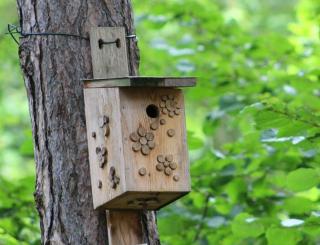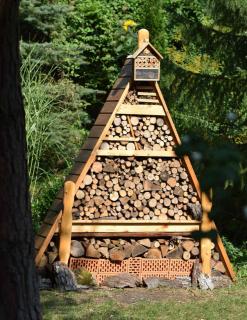

Birds, insects, hedgehogs… These small animals are very useful to help manage gardens in a natural manner. It makes a lot of sense to provide them with housing and shelter before winter sets in.
 Blue tits or black-capped chickadees, robins, sparrows, finches… These birds often reside in gardens, and others often drop by for a visit – watching them is always a source of joy. With all the caterpillars and insect pests they devour, they’re definitely among the gardener’s best friends. Help them survive over harsh winters when regular sources of food are depleted: simply set up a feeder on a stand or hang one to a branch, and fill it with seeds. Balls pressed from congealed fats are also a favorite treat. Purchasing them in stores is an option, but it’s actually very easy to make one yourself.
Blue tits or black-capped chickadees, robins, sparrows, finches… These birds often reside in gardens, and others often drop by for a visit – watching them is always a source of joy. With all the caterpillars and insect pests they devour, they’re definitely among the gardener’s best friends. Help them survive over harsh winters when regular sources of food are depleted: simply set up a feeder on a stand or hang one to a branch, and fill it with seeds. Balls pressed from congealed fats are also a favorite treat. Purchasing them in stores is an option, but it’s actually very easy to make one yourself.
During the cold season, birdhouses or nesting boxes are used by birds to stay out of foul weather. In spring, they’ll use them to raise their broods. Fall is the perfect time to set them up because many species are already out scouting for the ideal nesting spot. There are several different designs to choose from: letterbox style, half-open style… as long as you use rot-proof wood that is thick enough to stay put for a long while. Best make the bird house face south-east in a corner sheltered from strong winds.
 As regards insects, some are crucial for naturally ensuring biological equilibrium in the garden. Bees, wasps and bumblebees all pollinize plants. Hoverflies, ground beetles, green lacewings, ladybugs will consume entire aphid colonies. However, every time chemical treatments are used, these tireless workers are threatened and biodiversity drops. To help them survive, your garden can become a sanctuary for them to live an unfettered and helpful life.
As regards insects, some are crucial for naturally ensuring biological equilibrium in the garden. Bees, wasps and bumblebees all pollinize plants. Hoverflies, ground beetles, green lacewings, ladybugs will consume entire aphid colonies. However, every time chemical treatments are used, these tireless workers are threatened and biodiversity drops. To help them survive, your garden can become a sanctuary for them to live an unfettered and helpful life.
Provide them with shelter for the winter: building an “insect hotel” is easy and they’ll reside in it safely. Sometimes the shelter looks like a cute little house, at others it’s simply a shelf filled with carefully selected materials. In the end, all you need is some kind of wooden frame with boxes inside. Fill each box with a different type of material: wood drilled with lots of holes, clay fired bricks with cavities of various sizes, pinecones, straw… Wrap the bundles up with wire or mesh for them to stay in place for the season. Ladybugs will love finding materials and shapes that replicate nooks and crannies usually found between slabs of bark on trees.
Don’t forget the precious hedgehog: this little insect-eating mammal will put its excellent slug and snail-hunting skills to good use in exchange for a pile of logs in a corner. Its voracious appetite will keep spider, worm and snail populations in check. Branches piled up in a quiet spot of the garden atop a bed of dried leaves and twigs will make any hedgehog a very happy guest, especially if protected from the rain.
Fabienne Lisse